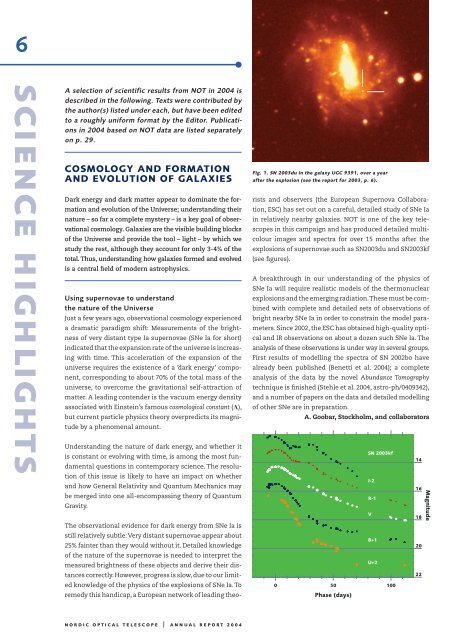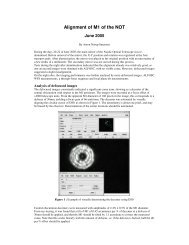NOT Annual Report 2004 (PDF) - Nordic Optical Telescope
NOT Annual Report 2004 (PDF) - Nordic Optical Telescope
NOT Annual Report 2004 (PDF) - Nordic Optical Telescope
You also want an ePaper? Increase the reach of your titles
YUMPU automatically turns print PDFs into web optimized ePapers that Google loves.
6<br />
SCIENCE HIGHLIGHTS<br />
A selection of scientific results from <strong>NOT</strong> in <strong>2004</strong> is<br />
described in the following. Texts were contributed by<br />
the author(s) listed under each, but have been edited<br />
to a roughly uniform format by the Editor. Publications<br />
in <strong>2004</strong> based on <strong>NOT</strong> data are listed separately<br />
on p. 29.<br />
COSMOLOGY AND FORMATION<br />
AND EVOLUTION OF GALAXIES<br />
Dark energy and dark matter appear to dominate the formation<br />
and evolution of the Universe; understanding their<br />
nature – so far a complete mystery – is a key goal of observational<br />
cosmology. Galaxies are the visible building blocks<br />
of the Universe and provide the tool – light – by which we<br />
study the rest, although they account for only 3-4% of the<br />
total. Thus, understanding how galaxies form ed and evolv ed<br />
is a central fi eld of modern astrophysics.<br />
Using supernovae to understand<br />
the nature of the Universe<br />
Just a few years ago, observational cosmology experienced<br />
a dramatic paradigm shift: Measurements of the brightness<br />
of very distant type Ia supernovae (SNe Ia for short)<br />
indicated that the expansion rate of the universe is increasing<br />
with time. This acceleration of the expansion of the<br />
universe requires the existence of a ’dark energy’ component,<br />
corresponding to about 70% of the total mass of the<br />
universe, to overcome the gravitational self-attraction of<br />
matter. A leading contender is the vacuum energy density<br />
associated with Einstein’s famous cosmological constant (),<br />
but current particle physics theory overpredicts its magnitude<br />
by a phenomenal amount.<br />
Understanding the nature of dark energy, and whether it<br />
is constant or evolving with time, is among the most fundamental<br />
questions in contemporary science. The resolution<br />
of this issue is likely to have an impact on whether<br />
and how General Relativity and Quantum Mechanics may<br />
be merged into one all-encompassing theory of Quantum<br />
Gravity.<br />
The observational evidence for dark energy from SNe Ia is<br />
still relatively subtle: Very distant supernovae appear about<br />
25% fainter than they would without it. Detailed knowledge<br />
of the nature of the supernovae is needed to interpret the<br />
measured brightness of these objects and derive their distances<br />
correctly. However, progress is slow, due to our limited<br />
knowledge of the physics of the explosions of SNe Ia. To<br />
remedy this handicap, a European network of leading theo-<br />
NORDIC OPTICAL TELESCOPE | ANNUAL REPORT <strong>2004</strong><br />
Fig. 1. SN 2003du in the galaxy UGC 9391, over a year<br />
after the explosion (see the report for 2003, p. 6).<br />
rists and observers (the European Supernova Collaboration,<br />
ESC) has set out on a careful, detailed study of SNe Ia<br />
in relatively nearby galaxies. <strong>NOT</strong> is one of the key telescopes<br />
in this campaign and has produced detailed multicolour<br />
images and spectra for over 15 months after the<br />
explosions of supernovae such as SN2003du and SN2003kf<br />
(see fi gures).<br />
A breakthrough in our understanding of the physics of<br />
SNe Ia will require realistic models of the thermonuclear<br />
explosions and the emerging radiation. These must be combined<br />
with complete and detailed sets of observations of<br />
bright nearby SNe Ia in order to constrain the model parame<br />
ters. Since 2002, the ESC has obtained high-quality optical<br />
and IR observations on about a dozen such SNe Ia. The<br />
analysis of these observations is under way in several groups.<br />
First results of modelling the spectra of SN 2002bo have<br />
already been published (Benetti et al. <strong>2004</strong>); a complete<br />
ana lysis of the data by the novel Abundance Tomography<br />
technique is fi nished (Stehle et al. <strong>2004</strong>, astro-ph/0409342),<br />
and a number of papers on the data and detailed modelling<br />
of other SNe are in preparation.<br />
A. Goobar, Stockholm, and collaborators



